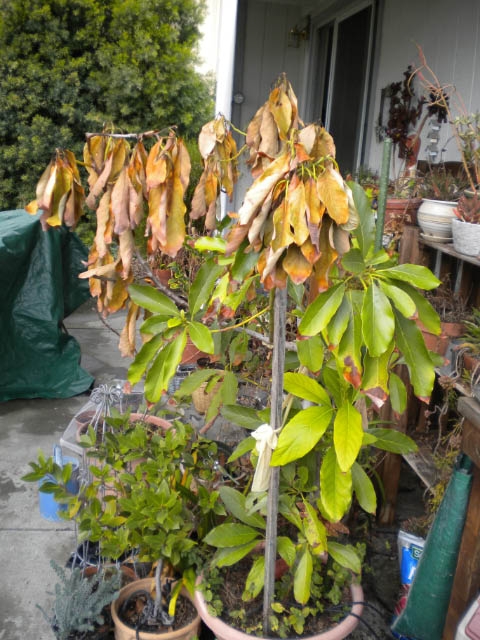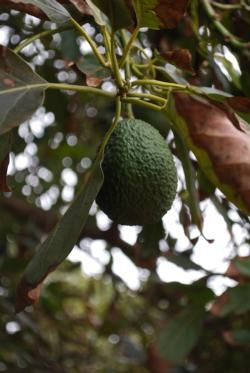Posts Tagged: Avocado
Avocados go from Meso-American backyards to 'world domination'
Avocados, now riding a tide of popularity appearing on toast in cookbooks and trendy restaurant menus, came late to commercial agriculture, reported Cynthia Graber and Nicola Twilley in Gastropod, a podcast that looks at food through the lens of science and history.
The 48-minute story features Mary Lu Arpaia, UC Cooperative Extension specialist based at the UC Kearney Agricultural Research and Extension Center in Parlier. Arpaia runs the UC avocado breeding program and is now studying varieties that will do well in the San Joaquin Valley climate.
On Gastropod, Arpaia outlined avocados' humble beginnings in their native Mexico and Central America.
"It was grown as a dooryard crop tree and valued for thousands of years," Arpaia said. "There was no intensive production of avocado until the industries in California and Florida started about 100 years ago."
The most popular variety is the Hass, which is derived from a seed planted in La Habra Heights by a hobby horticulturist, Rudolph Hass, a U.S. Postal Service worker.
"The thing against it (the Hass variety) was it turned black when ripe. It's a great tree with great fruit, but it's black," Arpaia said. "So it just shows how things have changed."
Consumers now embrace Hass' black, bumpy coat.
Graber and Twilley spent time on the show describing the "avocado toast" sensation around the globe. The duo quoted an article in Vogue that says 3 million new pictures of avocado toast are uploaded to Instagram every day.
The future for avocados looks bright. Already China imports 32,000 tons of avocados annually, but the market potential is much greater.
"I can't even imagine how big avocado will get in China," said one of the Gastropod hosts.
San Joaquin Valley farmers may one day produce avocados
Despite hot summers and cold winters, UC Cooperative Extension specialist Mary Lu Arpaia believes the San Joaquin Valley could be home to expanded California avocado production, reported Gregory Barber on Wired.com.
Currently, most of the state's avocados are grown in the mild coastal areas of San Diego and Ventura counties, where consumer-favorite Hass avocados flourish. But high land value and low water quality are limitations on the industry. The vast and fertile San Joaquin Valley beckons, but summer temperatures that frequently top 100 degrees and occasional winter freezes aren't ideal for Hass.
Arpaia has planted a variety of avocado cultivars at the UC Lindcove Research and Extension Center in eastern Tulare County to determine which trees produce creamy, nutty avocados, and maintain other desirable traits - such as high yield and small tree size - while subjected to the valley's climate extremes.
The California Avocado Commission funded the orchard's establishment.
"The industry wasn't really too keen about me putting a site here (at Lindcove)," Arpaia said. "But I'm stubborn and that's why it's here."
Each year three new avocado varieties are planted in the orchard. Though the breeding process is slow, Arpaia dreams that one day avocados will be sold in supermarkets much like the wide variety of apples.
"We're probably 20 years behind the apple industry at this point," Arpaia said. "Do we have anything out here that's going to achieve that dream?"
Finding an avocado variety ideal for valley temperatures has other benefits. It would give citrus farmers another option should their industry be threatened by Huanglongbing (HLB) disease. Already, the pest that spreads HLB, Asian citrus psyllid, is established in some parts of the valley and spreading. Once a tree is infected with HLB, it cannot be cured.
“Growers have made good money on avocados,” Arpaia said. “In the San Joaquin Valley, water is relatively cheap and we have better water quality than San Diego County. There are good, well-drained soils. Avocados' frost sensitivity is similar to lemons. If farmers have property where they can grow lemons, they could try avocados.”
Drought is forcing changes in California ag
California farmers are changing the way they grow avocados to deal with three distinct problems that are cutting into profits: rising fertilizer costs, spikes in water rates, and competition from avocados grown in Peru, Chile and Mexico, says University of California Cooperative Extension farm adviser Gary Bender. He was quoted in a story on Takepart.com about looming price increases for much-loved guacamole.
It takes 74 gallons of water to produce one pound of avocados — and drought-stricken California produces 95 percent of the avocados grown in the United States, wrote reporter Padma Nagappan.
Bender has been working with several farmers to experiment with high-density avocado planting, in which the trees are pruned to grow up rather than out. Growing more trees on less land will reduce water costs.
“The only way you can compete with cheaper imports and the high cost of water is if you go high-density and get more production per acre," said a San Diego area farmer.
An article in Growing Produce said the state has issued curtailments to some farmers who hold surface water rights. Because water rights law is so complex and because this is the first time many growers have had to navigate the finer details of water rights, Brenna Aegerter, University of California Cooperative Extension advisor in San Joaquin County, suggests that growers consult a professional for targeted advice.
Because of reduction in surface water availability, many growers are turning to groundwater to irrigate their crops. However, groundwater presents its own set of challenges, Aegerter says.
“There's a shallow water table but it's not good quality,” Aegerter says. “It's salty water. I think right now the main concern is what the water quality is going to be — whether it's going to be salty, and whether that will affect the crops.”
In the Westlands Water District, growers are using a combination of increased reliance on groundwater and fallowing for their water management plans, according to Tom Turini, UCCE advisor in Fresno County.
“The groundwater is lower quality than the district water — with levels of total dissolved salts and toxic ions varying from well to well — but generally higher than ideal, ” Turini says.
Southern California farmers harvesting uncommonly small avocados
An unusual weather pattern over the last year has led to an abundance of small-sized avocados on Southern California trees, reported National Public Radio. The radio news service sought an explanation from Gary Bender, UC Cooperative Extension advisor in San Diego County.
Bender said in his 29 years on the job he has not seen such tiny avocados as those being picked this year.
Typically, several months after pollination, high temperatures in July cause a significant amount of developing fruit to drop to the orchard floor. That didn't happen in the summer of 2012. The heavy crop on the tree, combined with low rainfall, cool temperatures and sluggish photosynthesizing, has likely caused the stunting, Bender said.
NPR reporter Alastair Bland found avocados being sold 6 or 10 to a bag for $1.
"That's just ridiculous," Bender said.
Freeze!
It's been so nice to be out in the garden. Buds are starting to swell on some shrubs, weeds are growing like gangbusters. I'm so ready for spring; I just want to clean everything up and plant away. But this time of year I have to stop myself from doing one particular garden chore. Some of my plants are looking a little, okay a lot, bedraggled because of frost damage. I could make them look so much better with just a few snips here and there.
For example, here is my avocado Persea americana. I started it from seed. It lives out on my back patio just under a patio cover. On nights I anticipate frost, I cover it with a sheet along with my dwarf citrus that also live on the patio. It's not looking very happy right about now. I think most of this is frost damage, but some might also be damage from the weight of the sheet on the little tree. I'm itching to cut all that brown damage off. However in Solano County on average, our last frost date is March 15th. We may get a few more frosts, yet. Those ugly damaged parts are protecting leaves and stem lower on the plant. If I cut the damaged parts off now that will just expose more of the plant to any remaining frosts. So for right now, I just need to... step away... from the pruners.

Low temperature injury on avocado. (photo by Karen Metz)






